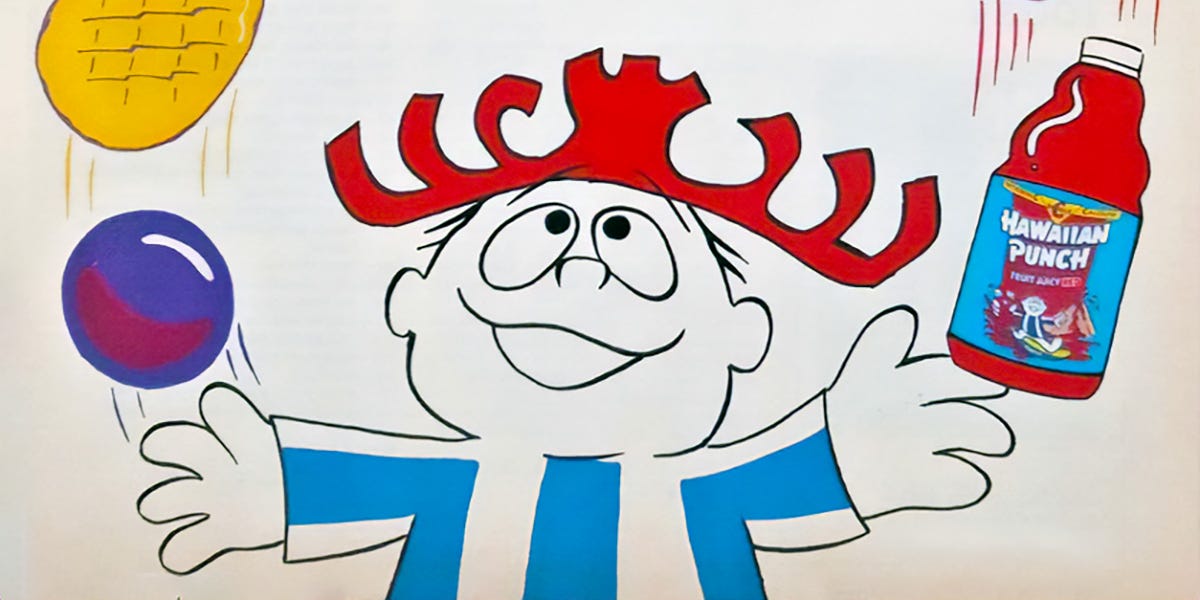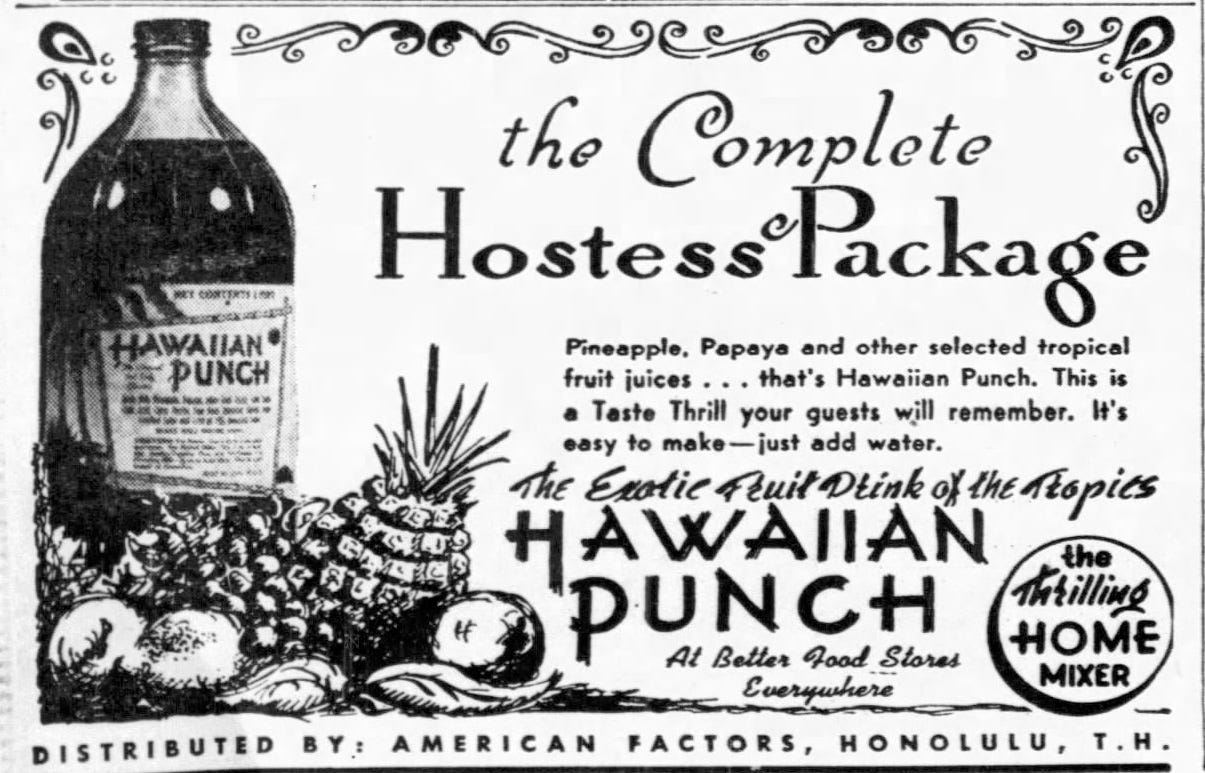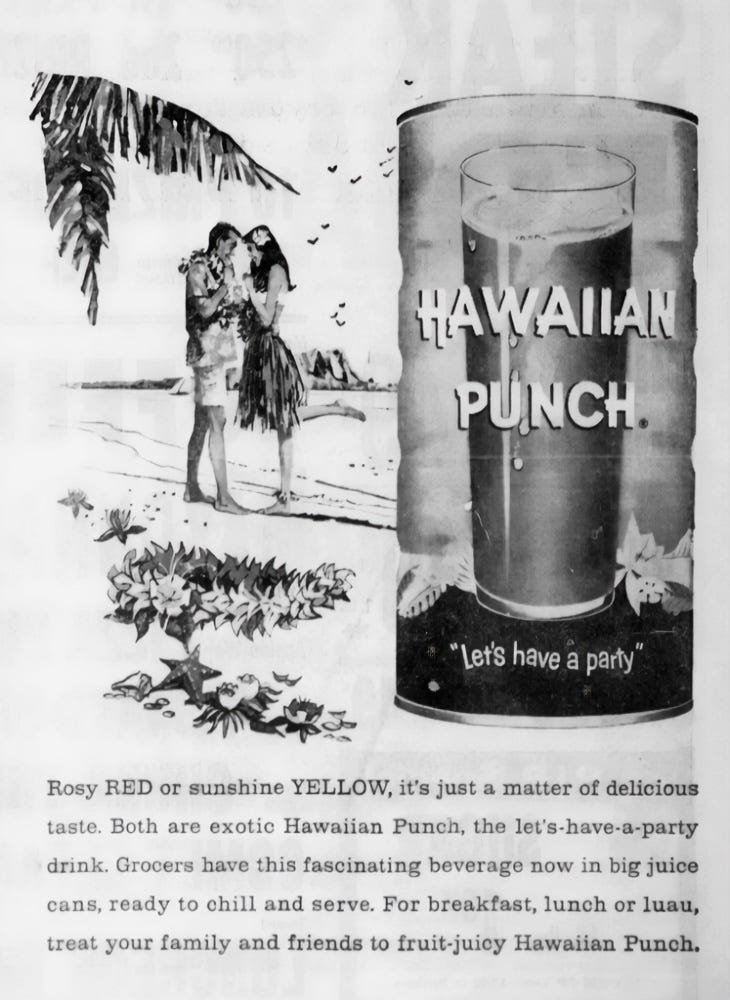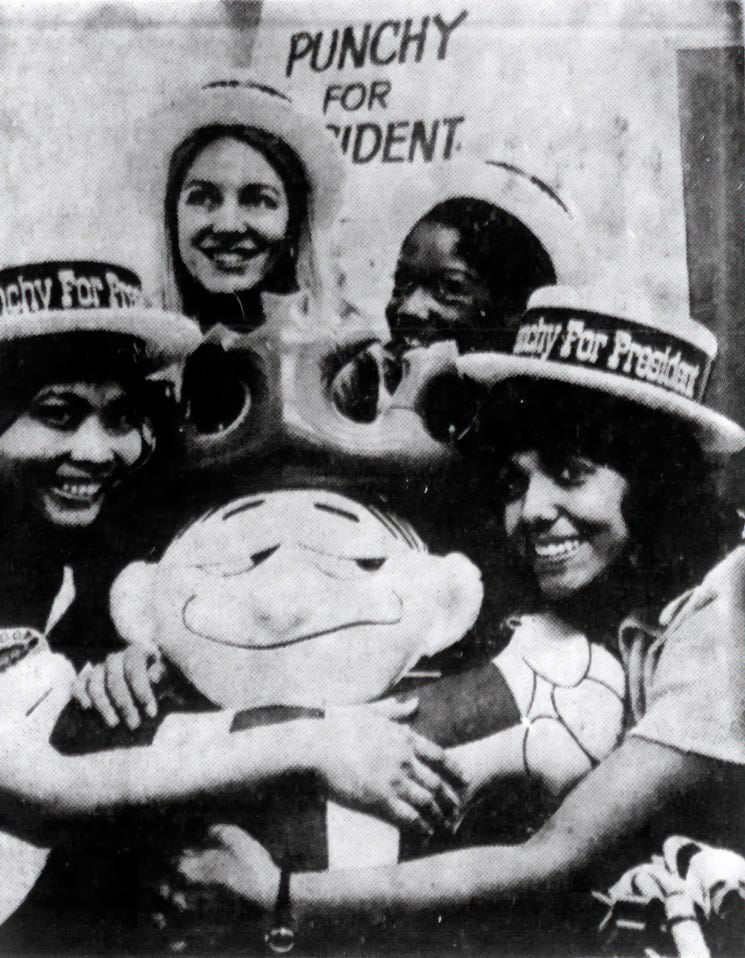
My family did its food shopping once a month. We had a strict list of foods we generally stuck with, but my mother allowed some flexibility. All of us were allowed to pick a treat that was just for us. While at the store, I would fret the entire time, trying to decide on what I would pick but also trying to negotiate an extra treat so I would not have to choose. Very often, the thing I finally decided upon might surprise people. It was not a cookie or a chip. It was a nice-sized red bottle of a drink I loved, Hawaiian Punch. Buying into the marketing, I always assumed this drink got its start in our 50th state. I would eventually find out its origin was an ocean away from Hawaii.
Hawaiian Punch began in 1934, but its story is tied to a broader trend in American pop culture. During the early 20th century, Hawaii was becoming increasingly popular. Travel posters, Hollywood musicals, and popular songs romanticized the islands as an exotic paradise. Because of its climate, the fruits grown there were considered novel. Flavors like pineapple and passion fruit were gaining traction in the American market. The idea of a drink that could capture the essence of these tropical flavors came at the perfect time.
In a garage in Fullerton, California, A.W. Leo, Tom Yates, and Ralph Harrison created a new confection under the company name Pacific Citrus Products. Originally known as Leo’s Hawaiian Punch, it started life as a syrup that you could put on top of ice cream. The syrup mixed five juices: orange, pineapple, passion fruit, guava, and papaya.
Leo’s Hawaiian Punch was at least a local hit, enough so that it attracted imitators. In 1940, the LaVida Bottling Company was served an injunction preventing them from using the Hawaiian Punch name on a soft drink it sold. A Superior Court judge declared that they were unfairly using the name trademarked by Pacific Citrus Products. Not only was LaVida ordered to stop using the name, they also had to give a full accounting of profits made while using it. This shows the product was popular enough to copy, and imitators were also serving it in a different format. The 1940 injunction was part of a growing trend in the food and beverage industry where companies began aggressively protecting brand names as packaged goods became more common in American households.
This was a heyday for soda fountains and ice cream parlors. Those businesses, along with bars, were the main customers for the product. While being used in these businesses, it became clear that customers enjoyed the flavor when mixed with plain or carbonated water and sometimes alcohol. Seeing an opportunity in 1946, the company was renamed Pacific Hawaiian Products, and Reuben P. Hughes took over the brand. Hughes wanted to sell directly to consumers, so he introduced a one-quart bottle filled with concentrate that you could buy at your local market.
After World War II, Hawaiian Punch started to take off in a big way. In 1950, the company launched its ready-to-serve version in 46-ounce cans. Five years later, in 1955, they introduced frozen concentrate. Around the same time, the brand began experimenting with new flavors. In 1954, they introduced Sunshine Yellow, a twist on the classic red flavor. The original Hawaiian Punch, which had been a mix of orange, pineapple, and other tropical juices, became known as the “Rosy Red” flavor. Sunshine Yellow replaced the orange juice and red coloring with a bright yellow hue. By the early 1960s, these products were distributed through more than 700 food brokers in the United States and sold by major grocery chains, independents, and military outlets, with international distribution expanding as well.
In 1961, Pacific Hawaiian acquired Royal Master Corporation, which made shoe-shining equipment, and later Cinch Products, which produced cake mixes and related items. Both subsidiaries had established sales networks, and their annual sales were expected to grow substantially. That year, the company launched Hawaiian Punch Sunshine Yellow Frozen Concentrate and Hawaiian Punch-On-A-Stick and planned a regional rollout of a concentrated and ready-to-drink exotic fruit drink line under the label “King of the Islands.” By this time, Hawaiian Punch had become a household name across the United States. It was time to go public.
In 1962, the company was listed on both the New York and Pacific Coast stock exchanges under the ticker PHP. President Reuben P. Hughes marked the occasion by purchasing the first 100 shares at the New York Stock Exchange. At the time, it operated four plants in California and Hawaii, had about 4,300 shareholders, and had grown annual sales from $1.1 million in 1952 to $23.7 million in 1961. The company had paid uninterrupted quarterly dividends since 1955 and had recently completed a 2-for-1 stock split, leaving 1,701,992 shares outstanding.
Later in 1962, R. J. Reynolds Tobacco Company entered negotiations to acquire the business in a stock deal valued at over $42 million. The plan called for exchanging one Reynolds share for every 1.8 Pacific Hawaiian shares, pending shareholder approval. At the time, the company produced Hawaiian Punch concentrates and frozen drinks, operated plants in California and Hawaii, and owned subsidiaries such as Hawaiian Fruit Growers Exchange, Cinch Products, and Royal Master Corporation. Its main plant was in Kahului, Maui, where it processed passion fruit, guava, and papaya for its products. At the time, tobacco companies like R.J. Reynolds were diversifying into packaged foods and drinks to offset growing health concerns about smoking and to reach new markets.
The brand underwent another shift when R.J. Reynolds completed its acquisition. The company began marketing Hawaiian Punch not just as a juice but also as a cocktail mixer. In 1973, the brand introduced single-serve 8-ounce cans, and in 1976, a powdered version of the drink was launched. From its humble beginnings, Hawaiian Punch had grown into a versatile product available in several formats, including liquid, powdered mix, and frozen concentrate.
In 1961, the Atherton-Privett ad agency created a 20-second Hawaiian Punch commercial produced by John Urie and Associates in Hollywood. Directed by Jean Guy Jacques, with characters Punchy and Oaf designed by Bob Guidi and John Urie, it featured Ross Martin as Punchy’s voice delivering the line, “Hey! How ’bout a nice Hawaiian Punch?” and Urie voicing Oaf’s “Sure.” Animated by Rod Scribner, the ad ended with Punchy leaning on a can of Hawaiian Punch saying, “Wasn’t that a refreshing commercial?” The spot won numerous awards. Punchy fit neatly into a broader advertising movement of the era that used animated mascots to make products more memorable and appealing to children. Although Punchy predated RJR’s ownership, the company expanded his presence into TV, magazines, comics, school items, toys, clothing, and more, calling him “the best salesman the beverage has ever had.” Punchy and Oaf (sometimes called Opie) remained in commercials into the 1980s and returned briefly in the early 1990s.
In one of his more unusual promotions, Punchy hit the campaign trail in 1972. That is when RJR Foods launched the “Punchy-for-President” campaign to promote Hawaiian Punch, turning its cartoon mascot into a tongue-in-cheek presidential candidate. Timed to a major supermarket industry convention, the stunt was designed to capture the attention of grocery buyers and secure better shelf space, especially against the drink’s more popular foe, Hi-C.
Public relations director John Frango scripted Punchy’s speeches with playful slogans like “We have nothing to feature but Hawaiian Punch” and even wrote a campaign song, “Punchy Days Are Here Again.” The campaign targeted children, ages three to twelve, who were seen as the most influential in persuading parents to buy the drink. By handing out “I’m for Punchy” labels and tying the promotion to store displays, RJR boosted sales of Hawaiian Punch, which at the time totaled about $50 million annually. The effort blended humor, character branding, and retail strategy, further cementing Punchy as the face of the product.
If you happened into Sea World in the 1970s/1980s and wandered past the Walrus pool on your way to the Sky Ride and happened to take a left instead of a right, you would find yourself in the magical Hawaiian Punch Village. There Punchy reigned and not only served up delicious Hawaiian Punch, but he had and animatronic band to entertain and sooth your frazzled nerves.
I was at Sea World in the eighties, when this should have still been open, but it weirdly didn’t make much of an impression. Which is weird since I loved the drink so much that bought a Hawaiian Punch raft to use while at the beach during that very trip. Maybe it was closed? Whatever the case, I have major regrets.
Advertising and promotions would continue, but one of my favorite ads for the product would be created in 1987. That is when this commercial with music by Mark Mothersbaugh from DEVO was released. The music and visuals are something. Enjoy the fuller 90 second version.
By the 1990s, Hawaiian Punch changed ownership again, with Procter & Gamble taking over. The brand eventually went to Cadbury Schweppes in 1999, and in 2008, it became part of Dr. Pepper Snapple Group. When Dr. Pepper Snapple merged with Keurig Green Mountain in 2018, Hawaiian Punch came under the umbrella of Keurig Dr Pepper. Today, the drink is still a favorite in many households. Hawaiian Punch is available in various flavors, like Fruit Juicy Red and Green Berry Rush, and is sold in ready-to-drink bottles, powdered mixes, and large containers.
More recently, Hawaiian Punch has responded to pressure from consumers with health concerns about the sugary drink. They have replaced some of the sugar with artificial sweeteners in an attempt to stay relevant. This reflects a larger shift in the beverage industry toward lower-sugar or artificially sweetened drinks, driven by consumer health concerns and changing dietary guidelines. Sadly, if you are a fan of the original, it is no longer available. For those who grew up with it, the taste now exists only in memory, a reminder of how products, like our own childhood experiences, rarely remain unchanged.
Trending Products






![NOW Country Classics: 90âs Dance Party[Lemon & Spring Green 2 LP]](https://m.media-amazon.com/images/I/61hVquUofcL._SL500_._SS300_.jpg)





